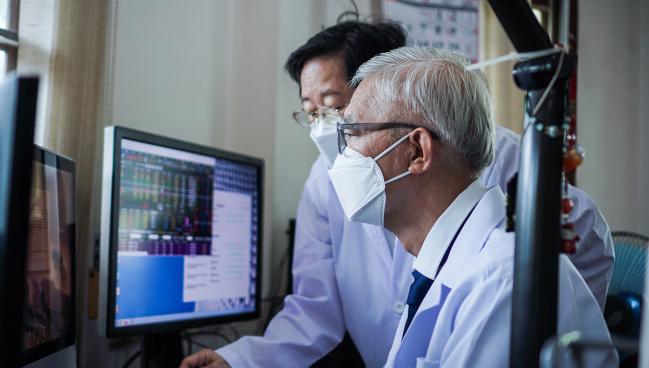LAA Occlusion With Watchman Provides Good Early Results in China
This shows “that left atrial appendage occlusion in an Asian population is working and is safe,” says researcher Chao Gao.

In China, left atrial appendage (LAA) occlusion using the first-generation Watchman 2.5 device (Boston Scientific) is being performed with high procedural success plus low rates of periprocedural complications and short-term adverse outcomes, prospective registry data show.
Over a recent 19-month period, implantation was successful in 99.5% of cases, on par with or better than rates reported in other Watchman registries (ranging from 95.6% to 98.3%), according to lead author Fangju Su, MD (Xijing Hospital, Xi’an, China), and colleagues.
Periprocedural complications were infrequent, and there were low 30-day rates of all-cause mortality (0.26%), death/stroke/systemic embolism (0.52%), and life-threatening or major bleeding (1.23%), they report in a study published online recently in JAMA Network Open.
Antithrombotic drugs used for stroke prevention in atrial fibrillation (AF) have reduced anti-ischemic benefits and greater bleeding risks in Chinese and other East Asian individuals when compared with other racial/ethnic groups—a situation known as the “East Asian paradox.” They may, therefore, have more to gain from nonpharmacological options, like LAA occlusion, but data on results of the procedure are more limited in this population.
Although the current analysis comes from a registry and not a randomized trial, it provides evidence “that left atrial appendage occlusion in an Asian population is working and is safe,” co-author Chao Gao, MD, PhD (Xijing Hospital), told TCTMD, adding that it will be important to build up the evidence base for other racial/ethnic groups, as well.
Watchman in China
The Watchman device became the first approved for LAA occlusion in China in 2013, and about 2,000 implants were being performed each year by 2017. RECORD is an ongoing prospective registry tracking real-world outcomes in the country, with follow-up planned out to 5 years.
The current analysis focuses on early outcomes in 3,096 patients (mean age 69 years; 57.6% men) treated across 39 Chinese centers between April 2019 and October 2020. They had a high stroke risk (mean CHA2DS2-VASc score 4.0) and a moderate-to-high bleeding risk (mean HAS-BLED score 2.4). Overall, 42.3% had a history of stroke and 45.2% had a HAS-BLED score of 3 or higher.
A high proportion of cases (41.6%) were done under local anesthesia, and although most involved transesophageal echocardiographic guidance (81.0%), many were performed using fluoroscopic guidance alone (15.9%) or intracardiac echo (3.1%). LAA occlusion was combined with catheter ablation for AF in 41.9% of patients.
Rates of device, technical, and procedural success were 99.5%, 99.1%, and 97.9%, respectively. Sites reported complete sealing of the appendage in 89.9% of cases, with leaks smaller than 3 mm in 8.1%, leaks 3 to 5 mm in 1.9%, and leaks larger than 5 mm in 0.1%.
Gao attributed the high rate of implantation success in this registry to knowledge that has been gained over the years about the anatomy of the LAA and optimal implantation techniques, as well as the requirement for operators to perform proctored procedures before trying them on their own.
Antithrombotic regimens varied, with direct oral anticoagulation (DOAC) monotherapy being most common (66.7%), followed by DOAC plus aspirin or a P2Y12 inhibitor (12.7%), warfarin monotherapy (12.0%), dual antiplatelet therapy (5.0%), and warfarin plus aspirin or a P2Y12 inhibitor (1.1%). Among patients with a HAS-BLED score of 3 or higher, those who were not adherent to antithrombotic recommendations from the Chinese Society of Cardiology had increased odds of death, stroke, systemic embolism, or any life-threatening/major bleeding at 30 days (adjusted OR 2.21; 95% CI 1.02-4.77).
There were 37 procedural complications, including 20 pericardial effusions, 11 cardiac tamponades, and a mix of other events. Within the first 7 days, two patients died of cardiac arrest, two had hemorrhagic strokes, and five had ischemic strokes; 33 had major bleeds and two had bleeding classified as life-threatening or disabling.
Procedural success and 30-day adverse outcomes were not significantly related to type of anesthesia, intraprocedural imaging guidance, or whether ablation was performed at the time of LAA occlusion. Center experience appeared to matter, however. Those performing at least 40 procedures each year had higher procedural success (adjusted OR 1.97; 95% CI 1.01-3.53) and a lower likelihood of life-threatening or major bleeding (adjusted OR 0.42; 95% CI 0.21-0.87).
Simplified Procedures Feasible
Senior author Ling Tao, MD, PhD (Xijing Hospital), told TCTMD that a key aim of the study was “to let our Chinese colleagues know about the whole picture of this procedure.” She noted that the more-experienced centers in the registry were more likely to use local anesthesia and fluoroscopic guidance alone for LAA occlusion. “That means a simplified procedure is possible, because we don’t see any difference regarding periprocedural events and complications,” said Tao.
The investigators caution in their paper, however, that “with current available evidence, we do not support the routine use of fluoroscopy guidance alone during LAA occlusion, and its efficacy still needs to be carefully evaluated in further studies before definitive recommendations are possible.”
Tao also highlighted the high frequency of combining LAA occlusion and catheter ablation for AF into a single procedure, and said this may be more common in China because most of the implanters were electrophysiologists; in other parts of the world, interventional cardiologists may make up a larger share. Insurance policies may play a role, too. Further research, she said, is needed to see whether the addition of ablation, and other procedural changes, has an impact on longer-term outcomes after LAA occlusion. A 1-year report is nearing completion.
This analysis included only patients treated with the Watchman 2.5 device, as the next-generation Watchman FLX is not yet being used in China. Tao said a randomized trial, called RECORD II, will compare LAA occlusion using either the Watchman 2.5 or Watchman FLX device with DOAC therapy in patients with AF who are undergoing PCI. The noninferiority trial will start recruitment soon, she said.
Todd Neale is the Associate News Editor for TCTMD and a Senior Medical Journalist. He got his start in journalism at …
Read Full BioSources
Su F, Gao C, Liu J, et al. Periprocedural outcomes associated with use of a left atrial appendage occlusion device in China. JAMA Netw Open. 2022;5(5):e2214594.
Disclosures
- RECORD was supported by Boston Scientific.
- Su, Gao, and Tao report no relevant conflicts of interest.





Comments